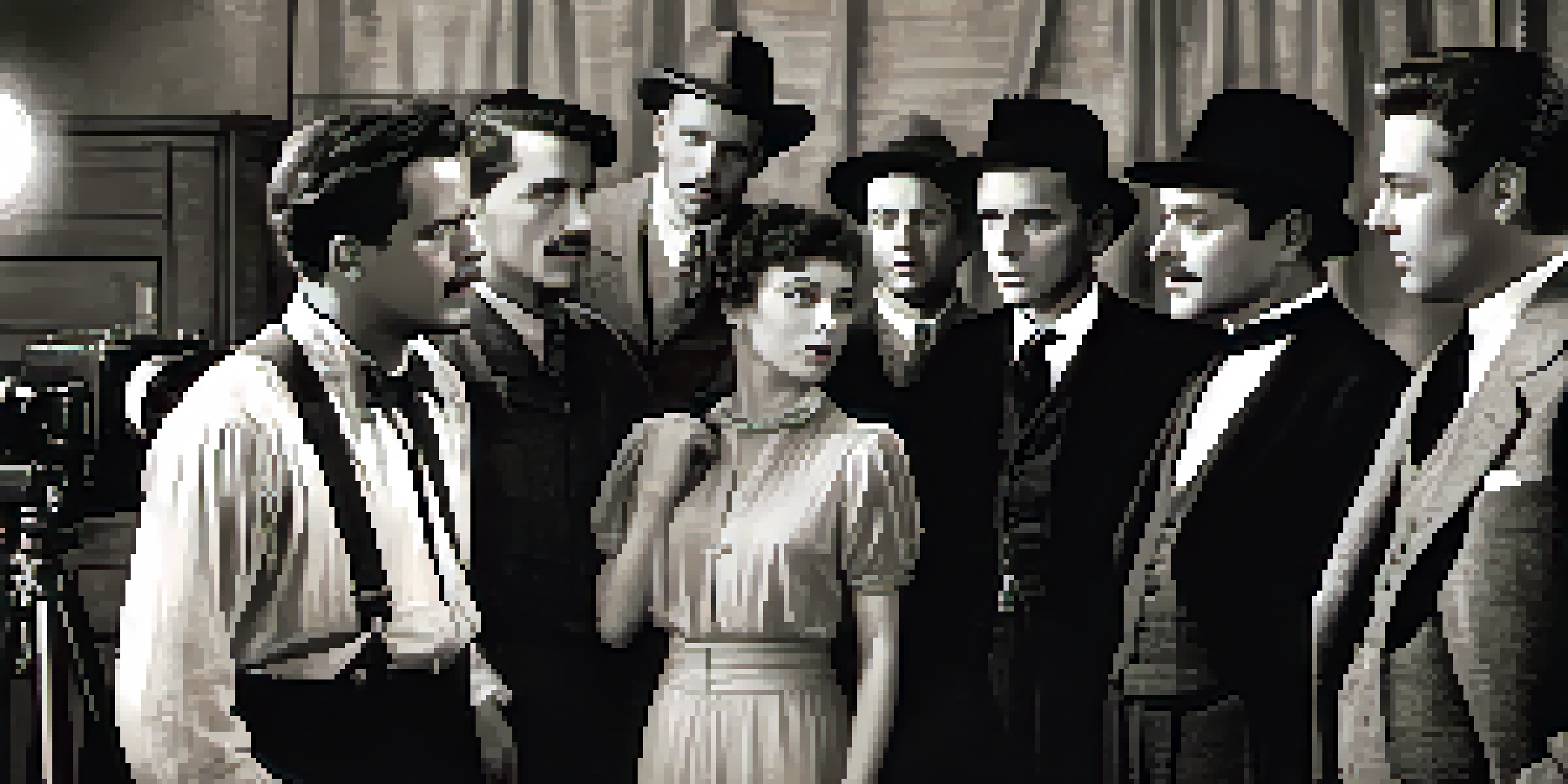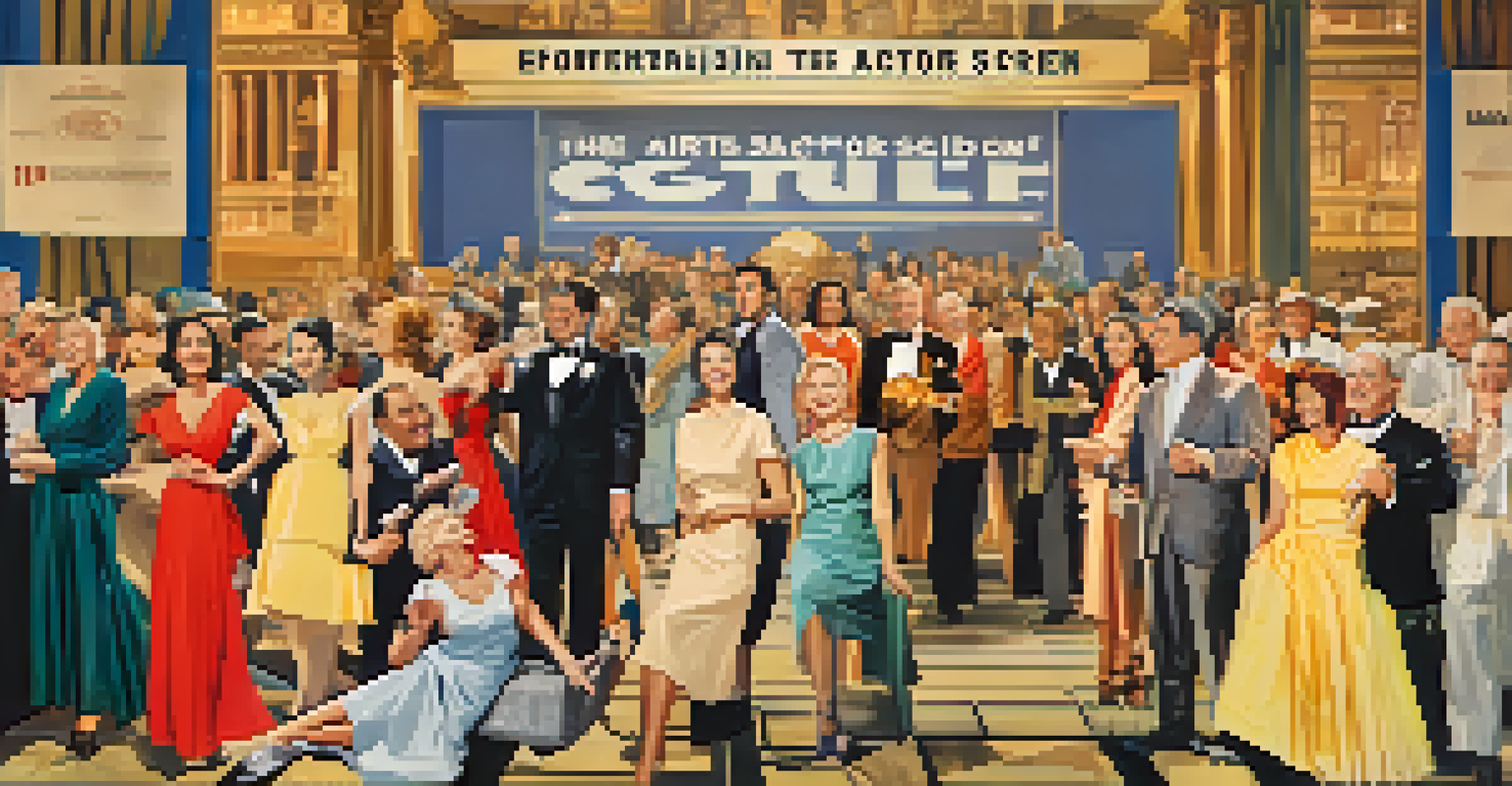The History of Screen Actors Guild: A Legacy of Advocacy

The Birth of the Screen Actors Guild in 1933
In 1933, a group of actors came together to form the Screen Actors Guild (SAG), driven by the need for better working conditions and fair treatment in Hollywood. This was a significant response to the rampant exploitation in the film industry, where many performers struggled to make a living. The founders, including notable actors like Edward G. Robinson and Jean Hersholt, aimed to create a united front to protect their rights and interests.
The only way to make a difference is to get involved.
Initially, SAG was met with resistance from studios, which were reluctant to cede power to a collective. However, the need for representation was undeniable, and as more actors joined the ranks, SAG began to gain influence. It was a period marked by the realization that unity could lead to meaningful change, paving the way for the guild to negotiate better terms on behalf of its members.
The establishment of SAG marked a turning point in the entertainment industry. It not only provided a platform for actors to voice their concerns but also set a precedent for other unions. This movement emphasized the importance of solidarity among workers and laid the groundwork for future labor rights advancements in Hollywood.
SAG's Role in Labor Rights During the Golden Age
As Hollywood entered its Golden Age in the 1940s and 1950s, SAG played a crucial role in advocating for actors' rights amidst rapid industry growth. During this time, the guild pushed for fair wages, better working conditions, and improved benefits, ensuring that performers received their due share of the industry's success. This era was marked by increased membership and the guild's growing influence over studio practices.

One of SAG's significant achievements during this period was the introduction of minimum salary standards for performers. This was a groundbreaking step that helped to elevate the financial stability of many actors who had previously struggled to make ends meet. By establishing these standards, SAG not only improved the lives of its members but also set a benchmark for other entertainment unions.
SAG's Formation for Actors' Rights
In 1933, the Screen Actors Guild was established to unite actors in their fight for better working conditions and fair treatment in Hollywood.
Moreover, SAG's advocacy extended beyond just pay; it also addressed issues of discrimination and unfair treatment within the industry. The efforts of the guild during this time laid the foundation for a more equitable Hollywood, fostering a culture where actors could speak out against injustices without fear of retribution.
The Fight for Health and Pension Benefits
In the 1960s, SAG recognized the need for health and pension benefits that would support actors throughout their careers and retirement. This initiative was crucial, as many actors faced financial insecurity and lacked access to essential healthcare services. The guild's commitment to improving the welfare of its members led to the establishment of the SAG Health Plan and the SAG Pension Plan.
In union there is strength.
These benefits not only provided financial security but also reinforced the idea that actors deserved protection beyond their on-screen roles. The introduction of these plans marked a significant milestone for SAG, as it demonstrated the guild's dedication to the long-term well-being of its members. This advocacy for health and pension benefits helped to set a standard in the industry, influencing other unions to pursue similar initiatives.
As a result, SAG became a model for actor welfare, showcasing the importance of unions in ensuring the financial health of artists. The guild's efforts during this time highlighted the interconnectedness of labor rights and personal security, solidifying its reputation as a champion for actors' rights.
SAG's Advocacy During Times of Change
The late 20th century brought significant changes to the entertainment industry, including the rise of new media and technology. SAG adapted to these shifts by advocating for its members in the face of challenges posed by cable television and later, digital streaming. The guild recognized the need to protect actors' rights in this evolving landscape, ensuring they received fair compensation for their work across various platforms.
During this time, SAG worked to negotiate contracts that addressed the unique circumstances of new media, such as residuals for streaming content. This was essential in ensuring that actors continued to benefit from the success of their work, regardless of the medium. SAG's proactive stance during these transitions demonstrated its commitment to staying relevant and responsive to the needs of its members.
Advocacy for Health Benefits
SAG championed the introduction of health and pension plans in the 1960s, providing crucial financial security and support for actors throughout their careers.
Moreover, as the industry faced issues related to diversity and representation, SAG took a stand to advocate for underrepresented groups. The guild's efforts to promote inclusivity within Hollywood highlighted its role not only as a labor union but also as a progressive force for social change in the entertainment sector.
The Merger: SAG and AFTRA Unite for Strength
In 2012, SAG merged with the American Federation of Television and Radio Artists (AFTRA), creating a powerful collective that better represented the interests of performers across various media. This merger was a strategic move to unify the voices of actors, broadcasters, and other media professionals under one umbrella. The newly formed SAG-AFTRA aimed to enhance bargaining power and streamline negotiations.
The unification of these two prominent unions allowed for a more robust approach to advocacy, addressing the changing dynamics of the entertainment industry. By pooling resources and expertise, SAG-AFTRA could better navigate challenges related to digital content, ensuring that all performers received equitable treatment. This collaboration emphasized the importance of solidarity in an industry that continues to evolve rapidly.
Furthermore, the merger underscored the commitment to inclusivity within the industry, as SAG-AFTRA pledged to prioritize representation and diversity in all aspects of its operations. By working together, the two unions aimed to create a more equitable entertainment landscape, reflecting the diverse voices and stories that enrich Hollywood.
SAG-AFTRA's Commitment to Social Justice
In recent years, SAG-AFTRA has expanded its focus to include social justice issues, advocating for fair treatment not just for its members but also for marginalized communities within the industry. The guild has actively worked to address systemic inequalities and promote diversity across all levels of Hollywood. This commitment reflects a broader understanding of the role unions play in advocating for social change beyond just labor rights.
SAG-AFTRA's initiatives have included campaigns to combat harassment, promote gender equality, and support underrepresented artists. By creating programs and resources aimed at fostering a more inclusive environment, the guild has positioned itself as a leader in the fight for social justice within the entertainment sector. This shift represents a recognition of the interconnectedness of labor rights and social equity.
Commitment to Social Justice
Recently, SAG-AFTRA has broadened its focus to include social justice issues, advocating for marginalized communities and promoting diversity within the entertainment industry.
Through their advocacy efforts, SAG-AFTRA has demonstrated that the fight for actors' rights goes hand in hand with the struggle for a more equitable industry. By championing social justice, the guild not only uplifts its members but also contributes to a cultural shift that values diversity and representation in Hollywood.
Looking Ahead: The Future of SAG Advocacy
As the entertainment industry continues to evolve, SAG-AFTRA faces new challenges and opportunities that require innovative advocacy strategies. The rise of artificial intelligence, changes in content distribution, and the gig economy are just a few of the issues that will shape the future of labor in Hollywood. SAG-AFTRA is committed to staying ahead of these trends, ensuring that actors’ rights are protected in an ever-changing landscape.
Looking ahead, the guild aims to strengthen its policies surrounding digital content and residuals, ensuring that actors receive fair compensation for their work in all formats. This forward-thinking approach reflects a deep understanding of the industry's dynamics and the importance of adapting to technological advancements. SAG-AFTRA's proactive stance will be crucial in safeguarding the rights of current and future generations of performers.

Moreover, SAG-AFTRA will likely continue to prioritize issues of diversity, equity, and inclusion, recognizing that these principles are essential for the industry's growth. By fostering a culture of belonging and representation, the guild aims to create a more inclusive Hollywood that reflects the diverse stories and talents of its members. The legacy of advocacy that SAG has built over the decades will undoubtedly guide its future endeavors.